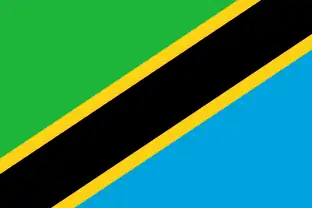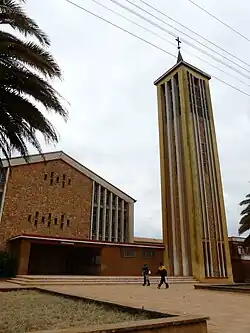Religion in Tanzania (2010)[1]
| Part of a series on the |
| Culture of Tanzania |
|---|
 |
| People |
| Languages |
| Religion |
| Literature |
| Music |
| Sport |
Christianity is the largest religion in Tanzania, with a substantial Muslim minority. Smaller populations of Animists, practitioners of other faiths, and religiously unaffiliated people are also present.[2][1]
Tanzania is a secular state and freedom of religion is enshrined in the country's constitution.
Statistics


Current statistics on the relative sizes of various religions in Tanzania are limited because religious questions have been eliminated from government census reports since 1967. Estimates for 2010 published by the Pew Research Center in 2012 indicated that 61.4% of the population were Christian, 35.2% Muslim, 1.8% practiced traditional folk religions and 1.4% were unaffiliated.[1] However, according to the Association of Religion Data Archives (ARDA), 55.3% of the population is Christian, 31.5% is Muslim, 11.3% practices traditional faiths, while 1.9% of the population is non-religious or adheres to other faiths as of 2020.[2]
According to the 2020 ARDA estimate, 29% of the population was Protestant and 27% was Catholic.[3] According to a Pew Research Center study conducted in 2012, 40% of the Muslim population of Tanzania identifies as Sunni, 20% as Shia, and 15% as Ahmadiyya, with 20% not specifying a denomination.[4] The ARDA estimates that most Tanzanian Muslims are Sunni, with a significant Shia minority, as of 2020.[2]
For many years estimates have been repeated that about a third of the population each follows Islam, Christianity and traditional religions.[5]
Religion-related statistics for Tanzania have been regarded as notoriously biased and unreliable.[6]
About 99 percent of the population in Zanzibar is Muslim.[7] The largest religion in Dar es Salaam is Islam, comprising around 70% of its total population.[8] There are also active communities of other religious groups, primarily on the mainland, such as Buddhists, Hindus, Sikhs, and Bahá'ís.[9]
Abrahamic religions
Christianity
The Christian population is largely composed of Roman Catholics and Protestants. Among the latter, the large number of Lutherans and Moravians point to the German past of the country while the number of Anglicans point to the British history of Tanganyika. All of them have had some influence in varying degrees from the Walokole movement (East African Revival), which has also been fertile ground for the spread of charismatic and Pentecostal groups.[10]
Islam
On the mainland, Muslim communities are concentrated in coastal areas, with some large Muslim majorities also in inland urban areas especially and along the former caravan routes. 30% of the country's Muslim population is Sunni; the remainder consists of several Shia subgroups (40%), mostly of Indian descent and the Ahmadiyya (15%),[11][12] and a smaller subset of Ibadism and nondenominational Muslim practitioners.[13]
Bahá'í Faith
Judaism
Indian religions

Buddhism
Hinduism
Hinduism is a minority religion in Tanzania.
Sikhism
Freedom of religion
The government of Tanzania and the semiautonomous government of Zanzibar both recognize religious freedom as a principle and make efforts to protect it. The government of Zanzibar appoints Muslim religious officials in Zanzibar. The main body of law in Tanzania and Zanzibar is secular, but Muslims have the option to use religious courts for family-related cases. Individual cases of religiously motivated violence have occurred against both Christians and Muslims, as well as those accused of witchcraft.[14] The freedom to practice religion is a human right in Tanzania.
In 2023, Tanzania scored 3 out of 4 for religious freedom.[15]
Notable places of worship
- Azania Front Lutheran Church – Lutheran
- Christ Church, Zanzibar – Anglican
- Gaddafi Mosque – Islamic
- Great Mosque of Kilwa – Islamic (Historical)
- Ijumaa Mosque – Islamic
- Kizimkazi Mosque – Islamic
- St. Joseph's Cathedral, Dar es Salaam – Catholic
See also
References
- 1 2 3 "Table: Religious Composition by Country" (PDF). The Global Religious Landscape. Pew Research Center. 18 December 2012. p. 50. Retrieved 25 December 2023.
- 1 2 3 "National Profiles".
- ↑ C, Joel (2023-05-05). "National Profiles". theARDA. Retrieved 2023-05-05.
- ↑ "The World's Muslims: Unity and Diversity" (PDF). Pew Forum on Religious & Public life. 9 August 2012. p. 128. Archived from the original (PDF) on 11 August 2012. Retrieved 10 December 2023.
- ↑ So repeated here: (USA government), Central Intelligence Agency. "The World Fact Book". Retrieved 25 May 2014.
- ↑ Abdulaziz Y. Lodhi and David Westerlund. "African Islam in Tanzania". Retrieved 25 May 2014.
- ↑ "Tanzania". United States Department of State. Retrieved 2022-10-15.
- ↑ Wijsen, Frans (2002-01-01). "When two elephants fight the grass gets hurt" Muslim-Christian Relationships in Upcountry Tanzania. Brill. ISBN 978-90-04-33408-3.
- ↑ "International Religious Freedom Report for 2013" (PDF). United States Department of State. Retrieved 17 October 2014.
- ↑ Fischer, Moritz (2011). "The Spirit helps us in our weakness": Charismatization of Worldwide Christianity and the Quest for an Appropriate Pneumatology with Focus on the Evangelical Lutheran Church in Tanzania". Journal of Pentecostal Theology. 20: 96–121. doi:10.1163/174552511X554573.
- ↑ "The World's Muslims: Unity and Diversity" (PDF). Pew Forum on Religious & Public life. August 9, 2012. Retrieved June 2, 2014.
- ↑ International Religious Freedom Report 2007: Tanzania. United States Bureau of Democracy, Human Rights and Labor (September 14, 2007). This article incorporates text from this source, which is in the public domain.
- ↑ Wortmann, Kimberly T. Omani Religious Networks in Contemporary Tanzania and Beyond. Diss. 2018.
- ↑ International Religious Freedom Report 2017 Tanzania, US Department of State, Bureau of Democracy, Human Rights, and Labor.
 This article incorporates text from this source, which is in the public domain.
This article incorporates text from this source, which is in the public domain. - ↑ Freedom House website, Retrieved 2023-08-01


